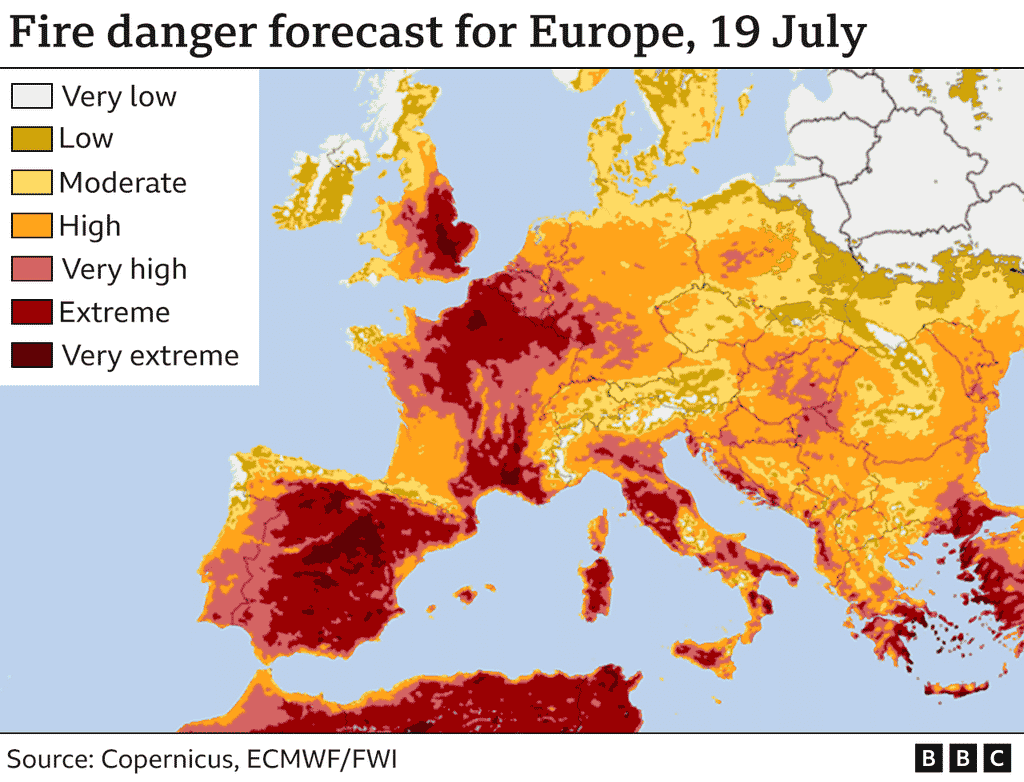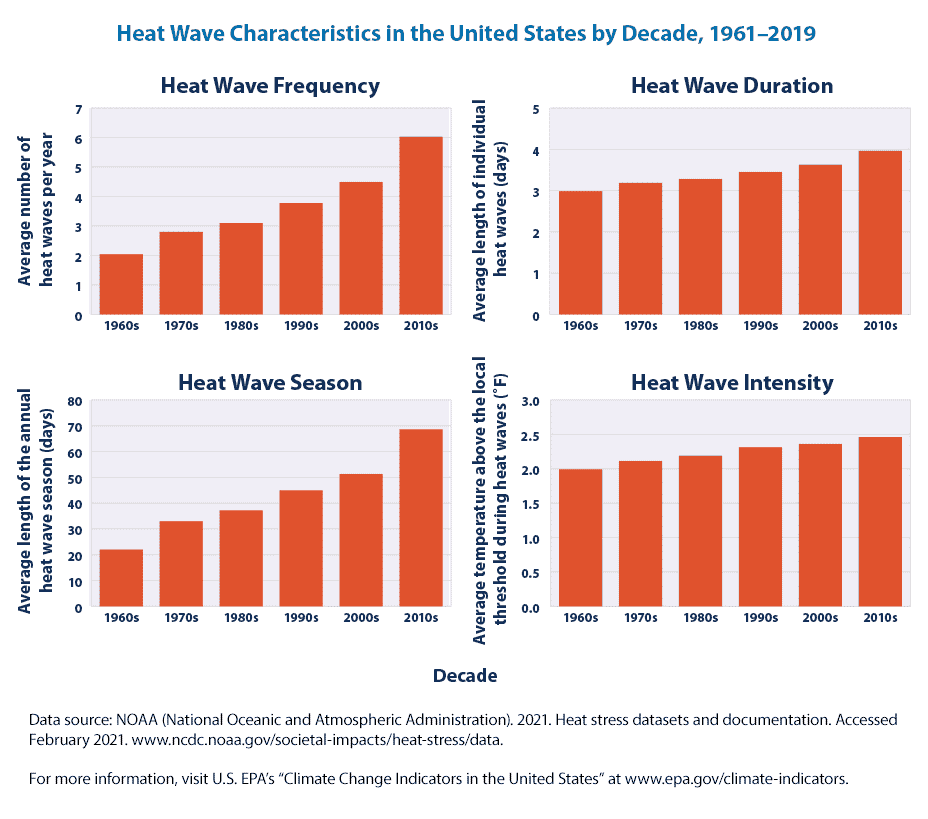As the world bakes in one of the worst summers in terms of frequency and intensity of extreme weather events, we reflect on what this summer’s heatwaves mean for the future of humanity. What implications do they have on life on Earth and do we still have a way out?
—
Summer Heatwaves: What Is Happening?
Most of us find it extremely hard to fathom what is going on in the world right now. Every single day for the past three months, we have woken up to the news of record-breaking temperatures baking some of the world’s biggest cities – from London and Shanghai to Tokyo and New York, of unprecedented wildfires destroying millions of hectares across Europe and the US, and of the consequences of these events on our food, water, and energy supplies.
While it is certainly not the first time we experience heatwaves during the summer months, the frequency, scale, and intensity of this year’s events are exceptionally terrifying.
However, what we are experiencing is the story of an announced tragedy; and we do not have to be top-tier scientists to understand that these weather events are a direct effect of global warming. For years, experts have warned humanity of the consequences of allowing global average temperatures to rise above 1.5C. In response to that, global leaders committed to drastic emission reduction targets and promised to invest money and resources in climate change mitigation by signing what went down in history as the Paris Agreement.
Now, as the hopes to maintain temperatures below that crucial level are fading, we are finally seeing what the future holds. The extreme events are purely the consequence of our reckless actions and, while they might have just sounded like something you only see in fictional movies until not long ago, they are very much real now.
The Impacts of Heatwaves Around the World
Currently, fewer than one million people live in areas that average 38-45C in the shade during the hottest month, temperatures likely to be too high for a human body to function well. But as the International Organization for Migration (IOM) estimates, that number will reach 30 to 60 million by 2100, and this is even if we managed to limit the average global temperature rise below 1.5C.
Global deaths related to excessively hot or cold conditions are estimated at around 5 million people annually, according to a Lancet study published in 2021. This equals 9.4% of global deaths each year and 74 extra deaths per 100,000 people. But excessive heat is not only affecting humans.
As the Met Office – UK’s national weather service – announced the country’s first-ever Level 4 Heat Alert in mid-July, the government as well as different sectors and industries were forced to take unprecedented actions to lower the risks of damage. Network Rail announced speed restrictions on train services amid fears of buckled rails and airports were forced to halt flights after runways melted in multiple locations. In the meantime, English farmers started feeding their chickens salty solutions akin to sports drinks to help replenish electrolytes. Heatwaves puts immense stress also on cows by altering their hormonal balance, lowering milk supplies, and likely hampering fertility.
Countries in Southern Europe are not doing any better. After experiencing the hottest May on record, Spain is now in the grip of its second heatwave of the summer, with temperatures in some southern areas set to reach 44C. Extreme heat put the railway network under unprecedented pressure, forcing it to cancel multiple trains as flames surrounded tracks in western parts of the country. Across the border in Portugal, the intense heatwaves fuelled large wildfires, with vast smoke clouds visible in the capital, Lisbon. So far this year, the country has seen more than 40,000 hectares of forest go up in flames. Meanwhile, Italy is battling an extraordinary water crisis, with extreme heat drying up the country’s longest and most important river, threatening crops and hydroelectric supplies.

Figure 1: Wildfire Dangers in Europe, July 2022
Alarming water shortages are also raising concerns in the US: In Nevada and Arizona, Lake Mead’s water levels sank to an all-time low, endangering drinking supplies for nearly 25 million Americans. Southwest and central areas are battling extreme heat, with cities in Texas, Colorado, Oklahoma, and Arkansas recording record temperatures blamed on the so-called ‘heat dome’, a persistent region of high pressure trapping heat over the area. While hospitals are being stretched to the breaking point, Texans have been urged to conserve energy as the power grid struggles to cope with a record rise in demand.
You might also like: Why Texas Cannot Ignore Climate Change
In Asia, at least 86 cities in the eastern and southern parts of the country have issued heat alerts so far this summer. Shanghai’s authorities have told its 25 million people to prepare for unusually hot weather, warning elderly people of the dangers of such high temperatures. Heatwaves like the ones going on right now are quite uncommon in the country’s most populous city, which has seen only 15 days with temperatures above 40C since record-keeping began in 1873.
Global Response: Are We Going Backwards?
It becomes clearer every day that summer heatwaves will be more common as the effects of climate change worsen, and countries around the world are beginning to adapt.
After a 2003 heatwave killed more than 70,000 people, European nations put in place public-health alert systems, opened cooling centres for the elderly, and initiated urban projects to replace concrete in cities with trees. The collective and large-scale response to the changing climate turned it into the most future-proofed continent. But this doesn’t mean that Europe is immune to climate change, as we are clearly seeing now. Especially in the North, cities are still very much unprepared to tackle extreme heat. In London, for example, only 1% of buildings have a fixed cooling system, and only about 3% to 5% are equipped with a portable cooling system, one of the lowest rates of air conditioning in the continent.
Another issue is the net-zero transition. While step one to mitigate climate change would be halving carbon emissions by 2030, it seems like they are now on the rise once again. One reason is certainly the rise in electricity demand coming from air conditioning and cooling systems. According to the International Energy Association (IEA), they already account for around 10% of the world’s electricity consumption. To make matters even worse, Europe is battling an unprecedented energy crisis sparked by the conflict in Ukraine, with several countries forced to revive coal plants to mitigate the gas shortage as Russia cuts supplies. Yet, as governments bolster energy stockpiles by burning more coal – despite the EU highlighting that this is just a “temporary” measure – they inevitably postpone their ambitious but much-needed net-zero transition plans. The extreme weather that the continent is experiencing is a grim reminder of the dangers of delayed climate action.
You might also like: The European Energy Crisis: How Are Countries Handling the Gas Shortage?
India experienced a similar situation earlier this year. Between March and May 2022, the country experienced a long-running wave of scorching and record-breaking heat. Residents were hit by temperatures surpassing 40C, while in some areas, surface land temperatures reached even 60C. Besides the health and environmental consequences, the heatwave sparked extremely high energy demand to power air-conditioning and cooling systems. In April, total power demand rose 13.2% and up to 75% in Northern areas. This led to a coal shortage which triggered the country’s worst power crisis in more than six years. Millions were left without power for up to nine hours a day and critical services such as hospitals were constantly threatened by blackouts. The fuel crisis and huge pressure on domestic supply forced the government to ease green rules for coal mines – allowing them to expand production by a further 10% without requiring a new impact assessment or having to consult local residents. Furthermore, the government took an unusual step by ordering coal-fired power plants to operate at full capacity and proceeded to revive production from nearly 100 inoperative mines in order to ensure enough supply to meet current and future demands.
You might also like: The India Coal Dilemma Amid Record-Breaking Heatwave
In terms of adaptation, the US is “way behind,” says Eric Klinenberg, Professor in Social Science at New York University. Indeed, air conditioning alone will not save us from climate change. To deal with hotter summers, countries need larger-scale interventions, and this begins by rethinking their infrastructure.
The best example to illustrate the country’s unpreparedness is Texas. The second-largest US state is consistently ranked among the top 10 states most affected by extreme weather events, such as drought, extreme heat, and wildfires. Within the past century, most of the state has warmed at an average of almost 1.5F (0.8C), and summers are getting longer and hotter. This summer’s heatwaves have led to record demand for air conditioning and electricity, sparking fears over power shortages, an extremely recurrent occurrence in the state. To add to the problem, the increasingly hot and dry climate has resulted in severe droughts that have brought its population and economy to their knees in recent years.
Texas has had a dry start to 2022 and, according to experts, nearly 84% of the state is now dealing with some level of drought, with a staggering 32% currently experiencing extreme drought conditions. Unfortunately, its economic growth is based on three, very thirsty sectors: fossil fuel production, real estate development, and agriculture. Each of them is badly impacted every time a drought occurs.

Figure 2: Heatwave Characteristics in the United States by Decade, 1961–2019
Do We Have A Way Out?
According to International Organization for Migration’s projections, large parts of the planet will become uninhabitable by 2100. No matter what we do, the world will continue to warm and extreme weather events will continue to bring death and destruction for decades to come. However, there is a thin line dividing us between a catastrophic future and a future in which – all things considered – the situation could slowly start to improve again. But we are extremely close to crossing that line forever.
The latest IPCC report published in May 2022 couldn’t have said it better: it is “now or never” to limit global warming to 1.5C; and while seeing what the world is going through right now and thinking about the future prospects scientists are offering us might be extremely discouraging, there is one good news about all this. As the scientist behind the report rightly said, we have all the tools and options we need to at least halve emissions in all sectors by 2030 and alleviate the pressure that climate change-triggered weather events are putting on our societies and ecosystems. According to the authors, with the resources and technologies available today, we can achieve a 40-70% greenhouse gas reduction by 2050. What we need, however, are the right policies.
So far, the report found more than a dozen countries have already experienced shrinking emissions rates for more than a decade. But there are cost-effective methods of cutting carbon that could help meet half the 2030 emissions target. With falling solar and wind prices, renewables are cheaper to generate electricity than fossil fuels in many countries, while AI and robotics are making energy usage and generation more efficient. Reusing and recycling products as well as minimising waste are key across all sectors, especially construction chemicals and materials such as steel.
Achieving a drastic emission reduction would ensure a future where the frequency and impact of heatwaves and other extreme weather events are substantially lower.
Besides mitigation measures, we can also change the way we are currently responding to heatwaves. As experts estimate that two-thirds of the world’s households will require an air conditioner by 2050, what we can do now is ensure that all new cooling systems are more energy-efficient and environmentally friendly. Of course, the most important part is still finding new energy sources to respond to the rising demand in the summer and this means replacing all fossil fuels with clean, renewables to generate the electricity that will power them. If we fail to do so, the easiest household solution to more heat – air conditioning – will only further exacerbate the source of the problem.
Now is really the time – and very likely also the last chance we will ever get – to step up our efforts to reverse the current course towards climate disaster. We can no longer wait. We must phase out fossil fuels immediately and scale up renewable energy generation to avoid the catastrophic impacts of climate change. With COP27 2022 coming up in November, governments must take steps to update their Nationally Determined Contributions (NDC) to stall global warming.
You might also like: Best Places to Live to Avoid Climate Change in 2022


















